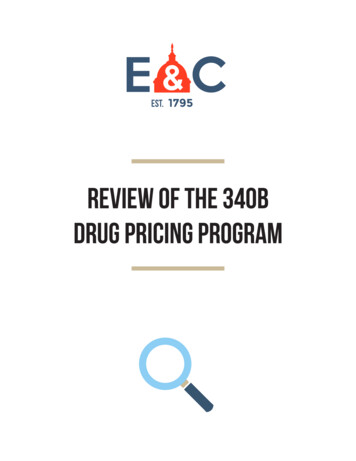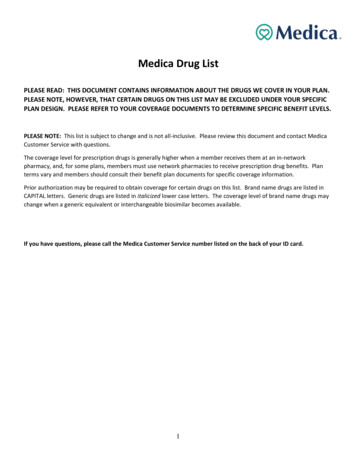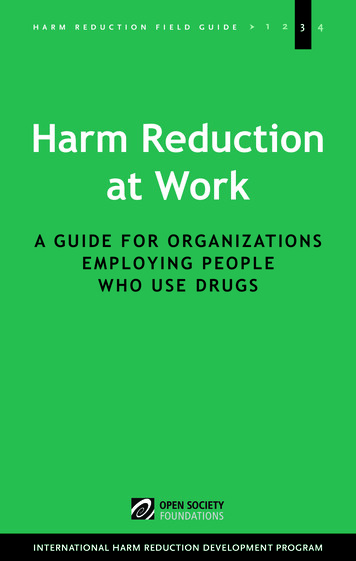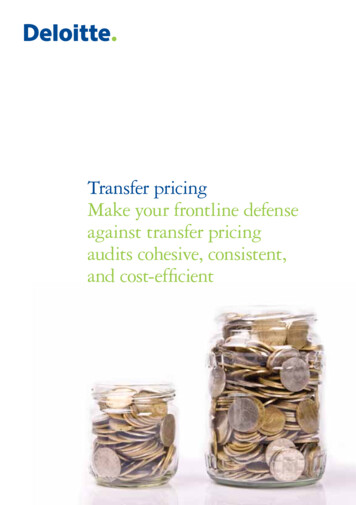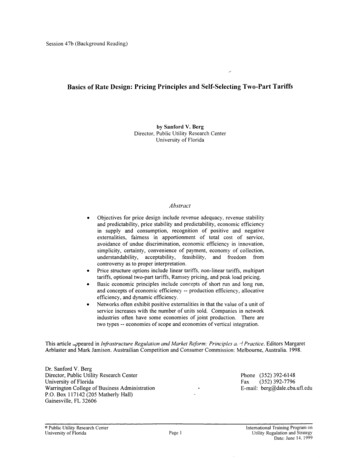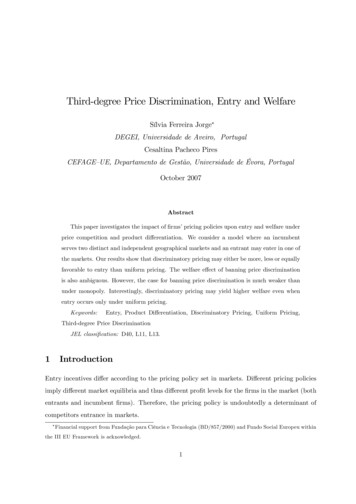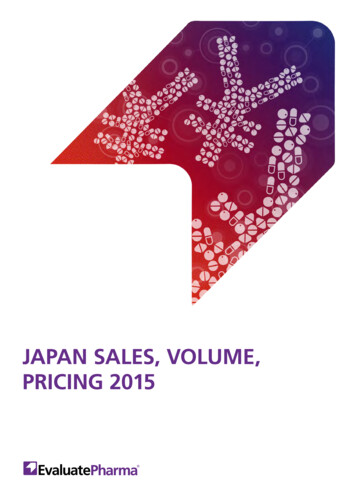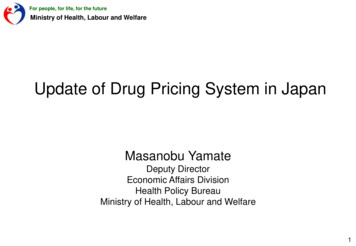
Transcription
For people, for life, for the �生労働省Ministry of Health, Labour and WelfareMinistry of Health Labour and WelfareUpdate of Drug Pricing System in JapanMasanobu YamateDeputy DirectorEconomic Affairs DivisionHealth Policy BureauMinistry of Health, Labour and Welfare1
Outline of Today’s presentation1. National Health Insurance and Drug Pricing System in Japan2. Reform of Drug Price Standard3. Health Technology Assessment2
1. National Health Insurance andDrug Pricing System in Japan3
Conceptual diagram of health insurance treatmentMinistry of Health,Labour and WelfareInsured person (patient)(2) Medical care service(medical treatment benefits)(1) Payment of premium(3) Co-paymentInsurance medical institutions, etc.Insurer(hospitals, clinics, dispensing pharmacies, etc.)Insurancedoctors(5) Sending approved bill(7) Payment of medicaltreatment fee(4) Claim for medical treatment fee(6) Payment of billedamountExamination and payment organization(Social Insurance Medical Fee Payment Fund, Federation ofNational Health Insurance Associations) Medical treatment fee is classified into medical, dental and dispensing fee. Specifically, medical fee is calculated by adding the scores given to individual medical actions that were provided,converting 1 point to 10 yen, in principle (so called, “fee-for-service system”). For example, when a patient is hospitalized for appendicitis, the first visit fee, hospital fee according to the number ofdays of hospitalization, surgery fee for appendicitis, test fee, drug fee, etc. are added. The insurance medical institutionwill receive the total amount less the co-payment charged to the patient from the examination and payment organization.4
Medical Services NOT Covered by MedicalInsurance(1) A illness or injury either during work or commuting to or fromthe workplace(2) Services which are provided for conditions which are notregarded as illnesses– ①Normal pregnancy and delivery– ②Physical check-ups and associated tests– ③Vaccinations etc.(3) Restrictions on unjust or unfair actions(4) The use of special drugs or special treatment methodsInsurance is not applied to the use of some special drugs or specialtreatment method which is not recognized as effective andappropriate by the medical community.55
Medicines listed in Drug Price Standard Drug Price Standard covers all medicines that are necessary formedication and dispensing by the National Health Insurance (NHI) .Drugs for medical use approved by Pharmaceutical and MedicalDevice Act are listed in Drug Price Standard in principle . There are some Drugs NOT listed in Drug Price Standard– OTC– A part of drugs for medical use as follows: Not suited for NHI such as Viagra6
National Health Insurance Drug Price StandardItems and prices of drugs usable in insurance-covered healthcare,specified by the Minister of Health, Labour and Welfare(common for all medical insurance systems, including health insurance, National HealthInsurance (NHI), and various mutual aid systems) Item list– A doctor or pharmacist operating under the health insurance program, in principle,must not use drugs other than “Drugs the Minister of Health, Labour and Welfarespecifies”.– Items listed in the NHI Drug Price Standard are stipulated as “Drugs the Minister ofHealth, Labour and Welfare specifies”. NHI Drug Price Standard specifies drugs usable in insurance-covered healthcare, andfunctions as an item list. Price table– When an authorized medical institution or pharmacy operating under the healthinsurance program makes insurance claims, the drug charge shall be calculated basedon the price specified in the NHI Drug Price Standard. NHI Drug Price Standard specifies the claimable amount of drugs used in insurancecovered healthcare, and functions as a price table.7
Overview of Current Drug PricingSystem1.Drug Price Standard defines price of medicines reimbursed inmedical institutions and pharmacies by the National HealthInsurance (NHI) .2.Minister of Health, Labour and Welfare announced “Rule of pricingmedicines” on February 10, 2016 agreed by Central Social InsuranceMedical Council (Chuikyo) .3.Price of medicines is periodically revised based on official survey ofthe actual sales price (market price) to medical institutions andpharmacies.8
Revision of price of listed drugsThe actual purchase prices paid by medical institutions and pharmacies (prevailing market price) aresurveyed (drug price survey) and the prices specified in the drug price standard are revisedperiodically based on the results of the survey.Drug price beforerevision, etc.Manufacture/saleAll transactionsare grasped bydrug price survey, etc.WholesalePrice difference2%Revision of drugprice, etc.New pricePurchaseprice atmedicalinstitutionsPurchaseprice atmedicalinstitutionsPrevailing market price oftendrops in response to the dropin drug price, etc.[Manufacturer][Wholesaler][Medical institution, pharmacy][Medical institution, pharmacy]9
Outline of drug price surveyFor items listed in the Drug Price Standard, the price is revised once every two years based on the market price.The market price survey carried out for this purpose is called the “drug price survey”. The drug price survey is oneof the General Statistics Surveys that require approval by the Ministry of Internal Affairs and Communicationsbased on the Statistics Act. Response from the survey subjects is voluntary.(1) Drug price main surveyThe survey is conducted for all items listed in the Drug Price Standard (approx. 16,000 items) for the purpose ofobtaining base data for revising the drug price.For the selling side, a nationwide survey is conducted for all drug distributors in Japan (pharmacies, general distributors,wholesale general distributors) that directly supply medical drugs to medical institutions, etc.For the purchase side, a survey is conducted on the purchase price for medical institutions, etc., selected at a certainrate.Subject: Selling sidePurchase sideWholesalerHospitalsClinicsInsurance pharmaciesAll1/10 of all1/100 of all1/30 of allApprox. 6,000 objectsApprox. 850 objectsApprox. 1,000 objectsApprox. 1,900 objectsPeriod: Transactions within a month in the surveyed fiscal year (conducted for September in FY2015)(2) Time variation surveyRegularly conducted for the purpose of accurately understanding the market price and supplementing the dataobtained by the main survey. The main purpose is to improve the reliability of the data obtained by the main survey. Aself-administered survey, similar to the main survey.Subject: Selling sideWholesalerExtractionApprox. 1,600 objects
QuantityPricing method for listed drugsMarket price distributionWeighted average consumption tax( 80)PriceAdjustablerange (2%)New price( 82)Price beforethe revision( 100)The new drug price is the weighted average of the wholesaler’s selling price to medical institutions and pharmacies (market price excluding tax), with consumption tax added as well as the span of theadjustable range (2% of drug price before the revision) for stabilizing drug distribution.New drug priceWeighted average of selling price tomedical institutions and pharmacies(market price excluding tax) 1 consumption tax rate(incl. local consumption tax) Span ofadjustable range11
Outline of Pricing New PharmaceuticalsNew Pharmaceuticalssimilar drug already listed1. Comparative Method (I)no similar drug listed2. Comparative Method (II)(New pharmaceuticalswith little novelty)1) PremiumInnovation Premium 70 – 120%Value Premium (I)35 – 60%Value Premium (II)5 – 30%Marketability Premium (I) 10 – 20%Marketability Premium (II) 5%Pediatrics Premium5 – 20%SAKIGAKE Premium 10 – 20 %4) Adjustment with foreign prices Reduction if 1.25 times orhigher Addition if 0.75 times orlower4) Adjustment with foreign prices Reduction if 1.25 times orhigher3. Cost Calculation MethodManufacturing(importing) costExpensesOperating ProfitDistribution costConsumption tax, etc4) Adjustment with foreign prices Reduction if 1.25 times orhigher Addition if 0.75 times orlower5) Adjustment of inter-specifications12* Kit materials with highly clinical values are to be further rewarded by 5%.
Pricing Rule for New Pharmaceuticals Comparative method IWhen there is a comparable drug with same indication in the list, the daily price of a newmedicine is to be equal to that of the comparable drug, to secure their fair competition in themarket. 【Comparative Method (I) 】–comparable drug: a brand-name drug listed within the last 10 years without its generic drug listed basically.1 tablet 50 yen3 tablets / day 1 tablet X yen2 tablets / day Daily price equivalence 50 yen X 3 tablets X yen X 2 tabletsX 75 yenSignificant points of a comparable drug:1) Indication2) Pharmacological mechanism3) Active ingredients and their structuralformula4) Route of administration, category ofdosage form, dosage form and way ofadministrationPremium is applied when a new pharmaceutical is proven to be highly useful.Innovation Premium70 – 120%5 – 60%Value PremiumMarketability Premium5% or 10 – 20%Pediatrics Premium5 – 20%SAKIGAKE Premium10 – 20%New mechanism of action, high efficacy or safety, and significant improvementin treatmentHigh efficacy or safety, significant improvement in treatment, etcOrphan drugs, etcPediatric indication/dosage/administration shown explicitly, etcThe new listing drugs designated as a target of SAKIGAKE designation system13 devices,SAKIGAKE Designation System: promoting R&D in Japan aiming at early practical application for innovative pharmaceutical products, medicaland regenerative medicines. –“SAKIGAKE” means “taking the lead [initiative],”
Cost Calculation MethodAdd up material cost, manufacturing expenses, etc., if there is nocomparable drugCalculated drug priceManufacturing(importing) costSales cost,research cost, etc.Material costOperating profitPersonnel expensesDistribution costOperating profit variesdrastically in the range from–50% to 100%,depending on the level ofnovelty, efficacy, or safetycompared to the existingtherapy.Manufacturing expensesConsumption taxIn principle, in case of exceeding the average coefficient for the pharmaceutical industry, calculation is performed using a coefficient.1414
Pricing Rule for New PharmaceuticalsCost calculation method Price of new pharmaceuticals without similar drugs, is determined by thetotal cost of raw materials, manufacturing, etc.【Cost Calculation Method】examplea) Cost of raw materialsb) Labor costc) Manufacturing expensesd) Manufacturing coste) Marketing, R&D costf) Operating profitg) Distribution costh) Consumption tax(active ingredients, additives, containers, etc.)( 3,818 yen (*1) X labor hours)( (d e f) ) * 0.452 (*2) )( (d e f) ) * 0.147 (*2) )( (d e f) g) ) * 0.073 (*3) )( 8%)Total Price of a new pharmaceutical(figures underlined: average coefficients of pharmaceuticalindustry (average of latest three years) is generally used)Increase of up to 100% (200%)or decrease of up to 50% (50%)is applied to the operating profit,depending on the novelty,efficacy and safety comparedwith existing treatment.*1: Unit cost of labor: “Monthly Labor Survey” (MHLW), average of 2012-2014*2: Ratio of expenses/labor, marketing/administration cost, operating profit:“Handbook of Industrial Financial Data” (Development Bank of Japan), average of 2012-2014*3: Ratio of distribution cost: “Current Report of Pharmaceutical Industry ” (MHLW), average of 2012-201415
Drug Price Determination Methodsfor new pharmaceuticalsAdjustment with Average Foreign Price Drug prices calculated by Comparative Method (I) and Cost Calculation Method is adjusted in case oflarge disparity between average foreign price.【Adjustment with Average Foreign Price】1) average foreign price: average of US, UK, Germany and France2) adjustment conditions:a) 1.25 times or higher than average foreign priceReduction*b) 0.75 times or lower than average foreign priceAddition1(1) 1.25 times or higher:31(2) 0.75 times or lower:3Temporally calculated5price average foreign6price Temporally calculatedprice1average foreignprice2 (Note: upper limit is as twice as the temporally calculated price) average foreignpriceaverage foreignprice16
New drugs price determination processPharmaceutical approvalOpinion of NHI price listingapplicant who desires toexpress opinionsNHI price listing application1st Drug Pricing OrganizationNotification of pricing planNo complaintComplaintIn principle, within60 days, within 90days at latestSubmission of appeal document2nd Drug Pricing OrganizationNotification of investigation resultReport and approval of pricing plan at general meeting of CSIMC** Central Social Insurance Medical CouncilNHI price listing(4 times per year)1717
Timing of listing of new drugs Basic rules Four times a year for new drugs(within 60 days in principle, within 90 days at the latest) Twice a year for report products and new kit products Twice a year for generics Timing of listing4 times a yearFebruary, May, August, November(corresponding to approval timing based onPharmaceutical Affairs Law)Report productsNew kit productsTwice a yearMay, NovemberGenericsTwice a yearJune, DecemberNew drugs
Generic drug pricing and price revision(1) Price revision of generic drugs to be newly listedMeasure It shall be “50% of the original product (for oral medicine, 40% if the number of brands exceeds 10)”. It shall be the same as before for biosimilar.(70% of the original product )(Both approved at a general meeting of the Central Social Insurance Medical Council on December 25, 2015)PreviousOriginalproductRevised 0.6 (0.5)*OriginalproductNew genericproduct(2) Price revision of generic drugs already listed 0.5 (0.4)*New genericproduct* When exceeding 10 brandsMeasure In the next drug pricing system reform, the drug price shall be calculated as below for all listed product groups where thecomposition, dosage form and specifications are the same, from the viewpoint of promoting the use of generic drugs(Approved at a general meeting of the Central Social Insurance Medical Council on December 25, 2013)(1) For a listed item whose calculated amount becomes below 30% of the maximum price, it shall be the weighted average for all relevant items (general name).(2) For a listed generic item whose calculated amount becomes 30% or more and below 50% of the maximum price, it shall be the weighted average for all relevantitems (by brand).(3) For a listed generic item whose calculated amount becomes 50% or more of the maximum price, it shall be the weighted average for all relevant items (by brand).Previous General name and uniform price for productat 20% or less Uniform price for product at 50% or higher Uniform price for product at 30-50% General name and uniform price for productless than 30%3 price ranges Uniform price for product in 20-30%Many priceranges Uniform price in units of 3% for product groupexceeding 30%Revised (already listed items)19
The drug price of the follow-on biologics (biosimilars) Case of follow-on products of biotechnology:0.7 multiplication of the drug price of the original product※If the medicine is more than 10 items, 0.6 multiplied※Depending on the degree of clinical trial, up to 10% addition is allowed Case of chemically synthesized products:0.5 multiplication of the drug price of the original product※If the medicine is more than 10 items, 0.4 multipliedOriginal productNew generic item(chemically synthesizedproducts)Follow-on biologics 0.7 0.520
Concept for new pharmaceuticals creation premiumMarketing ofgeneric productPrice Q’tyPatented periodSales of new pharmaceuticals Accelerate the development of innovativenew pharmaceuticals Resolution for unapproved/off-label useand drug lag issuesReplacement withgeneric productFaster recovery ofR&D investmentSales of generic product21Time
Shift in the quantity share for generic products and targetsVolume share target(Major policy 2017) Achieving 80% by September 2020, considering further promotion in orderto archive the target as soon as possible.(Source: MHLW survey)Target 9%35.8%20%Volume share means ratio of quantity of “generics” against quantities of “branded drugs with generics” and “generics”22
Revision of drug price that promotes replacement of drugs listed for a long time with generics “Exceptional reduction” shall be applied to individual brand name products that have not been appropriatelyreplaced by generics even after 5 years of listing of these generics. The percentage of exceptional reduction is shown below. Price reduction of brand name products with less than 30% of replacement rate by generics: 2.0% Price reduction of brand name products with less than 50% of replacement rate by generics: 1.75% Price reduction of brand name products with less than 70% of replacement rate by generics: 1.5%PricBrand eMore than 5 yearsnameproductsA yenApril 2014Reduction dueto prevailingmarket priceApril 2016April 20181100 productsExceptional reductionPrice listing of newdrugLaunch ofgenericsFirst revision when5years or more havepassed since thegenerics were listedTime23
“Premium to promote the development of newdrugs and eliminate off-label use” (1) PurposeFor new drugs for which generic drugs are not marketed andthat satisfy certain requirements, promotes solution ofproblems such as the pressing matter of off-label drugs andaccelerates discovery of innovative new drugs, bytemporarily delaying the reduction of drug prices based onthe market price for the period until generic drugs aremarketed.(Approved by Central Social Insurance Medical Council on December 21, 2011)24
“Premium to promote the development of newdrugs and eliminate off-label use” (2)1. Range of new drugs subject to the premiumThose that satisfy the requirements (1)-(3) below.Excludes those containing compounding agent for internal medicine (excluding HIV drugs) to which a corrective premium was not applied atthe time of NHI price listing and where 15 years have passed since NHI price listing or a generic drug is marketed.(1) New drug for which no generic drug is marketed (up to 15 years after NHI price listing)(2) Those where the deviation rate of the market price to the drug price does not exceed theweighted deviation rate average of all listed drugs(3) Those marketed by a marketer that developed or is currently developing off-label drugs to whichdevelopment is requested based on the results of deliberations at an Unlicensed Drugs ReviewMeeting, or that applied for items to which development was publicly invited and carried out or iscarrying out activities toward development, or those marketed by a marketer that is carrying outresearch and development of “drugs that truly contribute to improving the quality of medicalservices” separately from such items2. FormulaAmount calculated by the rulesin Chapter 3, Section 1 for thelisted item (drug price afternormal drug price revision) (Average deviation rate for all listed item – 2/100) 80/1005.41%(FY2014 4.94%)* Limited to FY2014 revision, upper limit is 108/105 of the pre-revision drug price.25
Image of drug price change of a new pharmaceuticals given the Premiumfor promoting new pharmaceuticals creationDrugpriceDrug price change forthe item in the scopeAccumulatedpremiumNormal drugprice changeReduction in price aligned withthe actual market priceTimeDrug pricelistingMarketing of a generic product orthe first drug price revision after 15years from the NHI listing26
「Framework of the reform of drug price system in FY2016」(approved in the general meeting of Central Social Insurance Medical Council on December 25,2015)Ⅱ Price revision of drugs already listed3.Basic drugsThe system named “Basic drugs” is designed to prevent the drug from being minimumpriced or being subject to the rule of re-pricing unprofitable products.As a trial implementation in the FY2016 drug pricing system reform,prices on those thatmeet all the requirements below will be fixed at that of a brand with biggest sales. Theprice will be maintained while they are authorized as basic drugs.① 25 years or more passed after NHI price listing and each deviation rate of the market price to the drugprice of a certain brand and drugs with same ingredient does not exceed the average deviation rate ofall listed drugs.② Having a multiplicity of uses ,for example, to be listed in general guidelines and widely used at medicalinstitutions③ drugs formerly subject to the rule of re-pricing unprofitable productsunti-pathogenic organism drugs and narcotic drugs forming the basis of health care for a long timeProfitable drugs are excluded from the basic drugs category. As for basic drugs,stablesupply should be maintained while the prices are maintained.27
Subject of basic drugs at the reform of drug pricesystem in FY2016The prices of basic drugs will be fixed at that of a brand with biggest salesand the price will be unchanged while they are authorized as basic drugs.Subject:134 ingredients 439 itemsCategoryNumber ofingredients(Number of cotic ��64)ExampleMain efficacyAMOLIN FINE GRANULESEBUTOL TabletsRetrovir CapsulesARASENA-A for I.V. InfusionMS ContinMORPHINE HYDROCHLORIDEINJECTIONvarious infectionspulmonary tuberculosis etcHIV infectionherpes simplex encephalitis etcpain relief of cancer with severe painpain relief or sedation when sufferingfrom severe pain etcepileptic fitcongenital hypothyroidismmultiple myeloma etcorganophosphorus agent poisoningRehydration when unable to intake orallyetcHYDANTOL POWDERTHYRADIN-S POWDEREndoxanPAMSOLDEM 3※ categorize as Unprofitable products when the drug can also be categorized into other categories28
2. Reform of Drug Price Standard29
Yearly medical and pharmaceutical expenditures of NHITrillion Yen3028.5%40.1T Yen3522.1%302025 24T Yen2015Medical expenditures1510108.9T Yen6.9T Yen55Ratio of drug expenditures (%)25Pharmaceutical alth expenditures of NHI and pharmaceuticals403030
Shift in overall medical costsThe medical costs for fiscal 2015 reached 41.5 trillion yen with year-on-year increases by approx. 1.5trillion yen (growth rate of 3.8%) from the previous fiscal year.45.039.340.0Total of overall medical cost 5.02.715.82.816.0Drug costs account for approx.6.0 trillion yen among themedical dispensing fees.Among the costs, antiviralscontribute to the costs of13.6 yen13.813.4 0.4 trillion13.3 approx.(accounting for 0.7% of thetotal growth of 201511.912.2Dispensing (technical fee)Dispensing (drug fee)Outside )Medical cost (trillion yen)30.032.435.337.840.031Prepared based on trends of medical cost and dispensing medical costs (Survey Division, Health Insurance Bureau, MHLW)31
Summary of Urgent Drug Price Revision for Fiscal 2016Background In recent years, a part of high-unit price anticancer drugs with extremely large market share have been marketed. Some ofsuch drugs exceeded the initial prospect because of the extended indication/dosage and administration resulting in drasticexpansion of the market share. Such drugs with huge market share expansion have been subject to repricing (drug price discount) conventionally doneevery two years. However, some may enjoy more than two years until repricing depending on the timing of the drug pricelisting. In reflection, the drug price was reviewed in fiscal 2016 as an emergency.Outline of emergency revision standard(1) Drugs in scopeA: Products with additional indication in the period of Oct. 2015-Mar. 2016B: Sales prospect for the fiscal 2016 (drug price basis) would exceed 100 billion yen with at least 10 times the prospected sales(2) CalculationThe formula for repricing for market expansion applicable for special cases will be applied to review the price.(Reference: outline of repricing for market expansion applicable for special cases)(1) Annual sales exceeds 100 billion yen but not more than 150 billion yen with at least 1.5 times the prospect sales Max reduction by 25%(2) Annual sales exceeds 150 billion yen with at least 1.3 times the prospect sales Max reduction by 50%Item in the scope of emergency revisionItem in scopeOpdivo(OnoPharmaceutical)Sales prospect*At listing: 3.1 billion yenFiscal 2016: 150billion yenDrug price before revision20 mg/bottle 150,200 yen100 mg/bottle 729,849 yenRevised drug price% change75,100 yen364,925 yen 50% 50%* At the time of listing: Prospective sales by the manufacturer at the peak demand at the time of drug price listing (2nd year) (listed on Sep. 2, 2014)Fiscal 2016: Estimated by MHLW with consideration for distribution expenses, consumption tax, price disparity rate, and possible indication extension in future based onthe annual sales estimated by the manufacturer (126 billion yen)Notified on: Nov. 24, 2016 Applied on: Feb. 1, 201732
“Re-pricing following market expansion” for the drugs with huge annualsales 【Revised】【Now(Previous)】Price will be reduced when annual sales of a drug exceed itsestimated figure to some extent.Ex)New drugs calculated usingcost accounting systemprice revision98 yenprice revisionRe-pricing followingmarket expansion98 yen95 yen25095 yen79 yen15014010010070654030Estimated annual sales251st year2nd year3rd year1300Annual sales1200Annual sales1000800500Annual sales605080Up to 50% price down150080Drug price(yen)Annual sales(100 million yen)Above 1000% of the estimatesandabove 10 billon yenAnnual salesabove 150 billion yenAbove 130% of theestimates160090260Above 200% of the estimatesandabove 15 billon yenUp to 25% price down100or200Annual sales100 150 billion yenAbove 150% of theestimates※First revision when 10 years ormore have passed since the drugwas listedAnnual sales(100 million yen)100 yenThe drugs with huge annual sales will be treatedas an exception of the current rule.4th year5th yearEstimatedannual salesXth yearEstimatedannual salesXth year33
Reform plan for fundamental reform of the drug pricing scheme(December 20, 2016) ①Recently, there have been innovative and extremely highly priced pharmaceutical products appearing on themarket, but the current drug pricing system has been unable to flexibly respond to these pharmaceuticalproducts, and there are concerns about the impact that it will have on the burden placed on the Japanesepeople and the finances of the medical insurance system.From the perspective of balancing the “sustainability of the universal healthcare system” and the “promotionof innovation,” and “reducing the burden placed on the Japanese people” and “improving the quality ofhealthcare,” which will benefit the Japanese people, the following will be undertaken towards a drastic reformof the drug pricing system while emphasizing PDCA.1. Drastic Reform of the Drug Pricing System(1) In order to enable responses to changes in circumstances after insurance listings and to enable a promptresponse to the expansion of markets beyond a given size that accompany additional indications, etc.,opportunities for new drug listings will be utilized to their maximum extent, and drug prices will be reviewedfour times per year.34
Reform plan for fundamental reform of the drug pricing scheme(December 20, 2016) ②(2) In order to timely reflect the market price in drug pricing and suppress the burden placed on the Japanesepeople, drug price survey will be conducted annually and will cover all products, and drug prices will be revisedbased on the results.To this end, in addition to the drug price survey currently being conducted biennially, a survey will beconducted for major businesses in the year in between, and drug prices for products with major pricediscrepancies (See Note) will be revised.(Note) A conclusion will be reached on the specifics within the next year.In addition, with regards to the drug price survey, the accuracy of the results of the survey and the surveymethods, etc. will be verified, and based upon this, we will consider reviewing the drug price surveythemselves, reaching a conclusion within the next year.(3) In order to promote the creation of innovative new drugs, the pricing premium system for the promotionof new drug development and the resolution of off-label use will be given a drastic and zero-based review, andby fully implementing cost-effectiveness evaluations including raising the price of drugs with high costeffectiveness, innovation will be evaluated by appropriately identifying the drugs that are truly effective,promoting investment in research and development.In order to fully implement cost-effectiveness evaluations, in addition to basing it on expert knowledge, themethod of implementation including organizations / systems from a third party perspective will also beconsidered, and a conclusion will be reached within the next year.35
Reform plan for fundamental reform of the drug pricing scheme(December 20, 2016) ③2. Future Initiatives in Conjunction with the Reform(1) Thoroughly ensure the accuracy and transparency of the drug price calculation method. Specifically, whiletaking into consideration the high confidentiality of the information for the pharmaceutical companies, theclarification of the basis for drug price calculations and the enhanced transparency of the drug price calculationprocess will be considered, and a conclusion will be reached. In addition, particularly for highly priced drugs,improvements to methods for adjusting foreign prices will be considered, such a
Drug prices calculated by Comparative Method (I) and Cost Calculation Method is adjusted in case of large disparity between average foreign price. 【Adjustment with Average Foreign Price】 1) average foreign price: average of US, UK, Germany and France 2) adjustment conditions: a) 1.25 times or higher than average foreign price Reduction*

